Imaginary Dinosaur-Bird Links
As you saw in earlier chapters, it's impossible for birds to have evolved from dinosaurs, since no mechanism can have eliminated the enormous physiological differences between the two groups. Despite this, evolutionists still raise the scenario of birds being evolved from dinosaurs in various ways. They frequently resort to news reports, using pictures of reconstructions and sensational headlines regarding these so-called dino-birds, as if they represented the true facts. These accounts are intended to convince people feathered dinosaurs once lived on Earth.
This scenario is presented persistently as it were a proven fact. All objections, criticisms and counter-evidence are totally ignored, clearly indicating that this is deliberate propaganda intended to impose dino-bird myths on society. The biased fossil interpretations we shall examine in the following pages reveal their hollow, deceptive nature.
The claim that birds evolved from dinosaurs is actually opposed by a great many paleontologists or anatomists who otherwise support the theory of evolution. As you have seen, two renowned ornithologists, Alan Feduccia and Larry Martin, think this scenario is completely erroneous. This is set out in the textbook Developmental Biology, taught in U.S. universities:
Not all biologists believe that birds are dinosaurs... This group of scientists emphasize the differences between dinosaurs and birds, claiming that the differences are too great for the birds to have evolved from earlier dinosaurs. Alan Feduccia, and Larry Martin, for instance, contend that birds could not have evolved from any known group of dinosaurs. They argue against some of the most important cladistic data and support their claim from developmental biology and biomechanics. 170
Many evolutionist publications refer to the thesis that birds evolved from dinosaurs as if it were based on solid evidence and accepted by the entire scientific community. They try to give the impression that the only subject up for debate is which species of dinosaur birds evolved from. Although Martin earlier supported the dino-bird claim, he eventually realized in the light of his research that it was invalid, and abandoned his former ideas:
Every time I look at the evidence formerly discovered and then make a claim about the origins of the theropod, I saw its inaccuracy. That is because everything shows its inadequacy. The truth of the matter is that…I seriously suspect that they have the same features with birds and don't think that there exist striking features supporting that birds are of theropod origin. 171
Feduccia admits that concerning the origin of birds, the theory of evolution finds itself in a state of uncertainty. He attaches no credence to the deliberately maintained dino-bird controversy, which is in fact groundless. Important information is contained in his article, "Birds Are Dinosaurs: Simple Answer to a Complex Problem," published in October 2002 in The Auk, the journal of the American Ornithologists' Union, in which the most technical aspects of ornithology are discussed. Feduccia describes in detail how the idea that birds evolved from dinosaurs, raised by John Ostrom in the 1970s and fiercely defended ever since, lacks any scientific evidence, and how such an evolution is impossible.
Feduccia is not alone among evolutionists in this regard. Peter Dodson, the evolutionist professor of anatomy from Pennsylvania University, also doubts that birds evolved from theropod dinosaurs:
I am on record as opposing cladistics and catastrophic extinction of dinosaurs; I am tepid on endothermic dinosaurs; I am skeptical about the theropod ancestry of birds. 172
Despite being an evolutionist, Dodson admits the unrealistic claims of the theory of evolution, and has come in for severe criticism from his evolutionist colleagues. In one article, he responds to these criticisms:
Personally, I continue to find it problematic that the most birdlike maniraptoran theropods are found 25 to 75 million years after the origin of birds . . . .Ghost lineages are frankly a contrived solution, a deus ex machina required by the cladistic method. Of course, it is admitted that late Cretaceous maniraptorans are not the actual ancestors of birds, only "sister taxa." Are we being asked to believe that a group of highly derived, rapidly evolving maniraptorans in the Jurassic gave rise to birds, as manifested by Archaeopteryx, and then this highly progressive lineage then went into a state of evolutionary stasis and persisted unchanged in essential characters for millions of years? Or are actual ancestors far more basal in morphology and harder to classify? If the latter, then why insist that the problem is now solved? 173
Alan Feduccia sets out an important fact concerning the dino-birds said to have been found in China: the "feathers" on the fossils said to be those of feathered dinosaurs are definitely not bird feathers. A considerable body of evidence shows that these fossil traces have nothing at all to do with bird feathers. He says this in an article published in The Auk magazine:
Having studied most of the specimens said to sport protofeathers, I, and many others, do not find any credible evidence that those structures represent protofeathers. Many Chinese fossils have that strange halo of what has become known as dino-fuzz, but although that material has been "homologized" with avian feathers, the arguments are far less than convincing. 174
Citing Richard O. Prum, one of the supporters of the dino-bird claims, as an example, Feduccia goes on to mention the prejudiced approach so prevalent on the subject:
Prum's view is shared by many paleontologists: birds are dinosaurs; therefore, any filamentous material preserved in dromaeosaurs must represent protofeathers. 175
Latest Research Has Dealt a Severe Blow to Feathered Dinosaur Claims |
 |
| The fossilized structures referred to as dinosaur feathers were shown by Theagarten (Solly) Lingham-Soliar, a paleontologist from Durban-Westville University in South Africa to be nothing more than decayed connective tissue. Professor Lingham-Soliar performed an experiment by burying a dolphin in river mud, semi-permeable to air for a year. The reason a dolphin was selected was tshat its flesh is easy to analyze. At the end of this period, the professor examined the dolphin's bunches of collagen—which constitutes connective tissue in the bodies of most living things— under a microscope. According to him, the decayed collagen in the dolphin's body bore "a striking resemblance to feathers." 1 The German magazine Naturwissenschaften commented that: "The findings throw serious doubt on the virtually complete reliance on visual image by supporters of the feathered dinosaur thesis and emphasize the need for more rigorous methods of identification using modern feathers as a frame of reference." 2 With this finding, it emerged that even a dolphin could leave behind traces of apparent feathers. This once again showed that there are no grounds for regarding extinct dinosaurs with "feathers" as proto-birds. 1. Stephen Strauss, "Buried dolphin corpse serves science," 11 November 2003; http://www.theglobeandmail.com/servlet/ArticleNews/TPStory/LAC/20031111/UDINO11/TPScience/ |
According to Feduccia, one factor that invalidates this preconception is the presence of these same traces in fossils that have no relationship with birds:
Most important, "dino-fuzz" is now being discovered in a number of taxa, some unpublished, but particularly in a Chinese pterosaur and a therizinosaur, which has teeth like those of prosauropods. Most surprisingly, skin fibers very closely resembling dino-fuzz have been discovered in a Jurassic ichthyosaur and described in detail. Some of those branched fibers are exceptionally close in morphology to the so-called branched protofeathers ("Prum Protofeathers"") described by Xu. That these so-called protofeathers have a widespread distribution in archosaurs is evidence alone that they have nothing to do with feathers. 176
Feduccia recalls that various structures found around these fossils and thought to belong to them, were later determined to consist of inorganic matter:
One is reminded of the famous fernlike markings on the Solnhofen fossils known as dendrites. Despite their plantlike outlines, these features are now known to be inorganic structures caused by a solution of manganese from within the beds that reprecipitated as oxides along cracks or along bones of fossils. 177
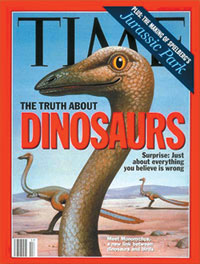 |
| Mononychus is one of the fossils used as a vehicle for evolutionist propaganda and depicted with feathers in the 26 April 1993 edition of Time magazine. It was later realized, on the basis of further evidence, that this creature was not a bird. |
The fossil beds preserve not only an indefinite structure such as dino-fuzz but also bird feathers. But all the fossils presented as feathered dinosaurs have been found in China. Why should these fossils have not emerged from anywhere else in the world—Feduccia draws attention to this intriguing state of affairs:
One must explain also why all theropods and other dinosaurs discovered in other deposits where integument is preserved exhibit no dino-fuzz, but true reptilian skin, devoid of any featherlike material (Feduccia 1999), and why typically Chinese dromaeosaurs preserving dino-fuzz do not normally preserve feathers, when a hardened rachis, if present, would be more easily preserved. 178
Feduccia states that some of these creatures portrayed as feathered dinosaurs are simply extinct reptiles with dino-fuzz and that others are genuine birds:
There are clearly two different taphonomic phenomena in the early Cretaceous lacustrine deposits of the Yixian and Jiufotang formations of China, one preserving dino-fuzz filaments, as in the first discovered, so-called "feathered dinosaur" Sinosauropteryx (a compsognathid), and one preserving actual avian feathers, as in the feathered dinosaurs that were featured on the cover of Nature, but which turned out to be secondarily flightless birds. 179
Peter Dodson, on the other hand, says, "I hasten to add that none of the known small theropods, including Deinonychus, Dromaeosaurus, Velociraptor, Unenlagia, nor Sinosauropteryx, Protarcheaeopteryx, nor Caudipteryx is itself relevant to the origin of birds."180 He means that these creatures cannot be the ancestors of birds because the earliest known bird, Archaeopteryx, lived long before the Cretaceous Period.
In short, the fossils portrayed as feathered dinosaurs or dino-birds either belong to certain flightless birds like today's ostriches, or else to reptiles possessed of a structure known as dino-fuzz which has nothing to do with actual feathers. There exists not a single fossil that might represent an intermediate form between birds and reptiles. Therefore, the claim that fossils prove that birds descended from dinosaurs is completely unrealistic.
1) The Alleged Intermediate From: Mononychus
One of the best-known fossils in the alleged dino-bird chain is Mononychus, discovered in Mongolia in 1993 and claimed to be an intermediate form between dinosaurs and birds. Although not the slightest trace of feathers was found in this fossil, Time magazine reconstructed the creature with feathers on the cover of its 26 April, 1993 issue. Subsequent evidence revealed that Mononychus was no bird but a fossorial (digging) theropod.
The fact that this fossil had a bird-like breastbone and wrist bones led evolutionists to interpret Mononychus as an intermediate form. Biased interpretations and support from the media gave the impression that some proof existed to back this up. However, the anatomical features depicted as evidence are also found in other animals, such as moles. These inferences represent no evidence at all and they have only led to misinterpretations.
Writing to Science News, Richard Monastersky reports, based on observations, why this fossil cannot be classified;
Mongolian and U.S. researchers have found a 75-million-year-old bird-like creature with a hand so strange it has left paleontologists grasping for an explanation. . . Paul Sereno of the University of Chicago notes that Mononychus had arms built much like those of digging animals. Because moles and other diggers have keeled sternums and wrists reminiscent of birds, the classification of Mononychus becomes difficult.181
In addition, this fossil is at least 80 million years younger than Archaeopteryx—which totally undermines any proposed
2) Bambiraptor Feinbergi, Depicted with Imaginary Feathers
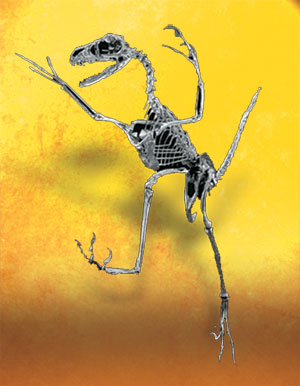 |
| Evolutionist media immediately give certain bird-like features to biased interpretations. The fossil Bambiraptor feinbergi, claimed to be an intermediate form between dinosaurs and birds, was depicted as a feathered reptile in media illustrations. However, there is no evidence that this creature ever had feathers. |
In 1994, another dino-bird claim was made on behalf of a fossil called Bambiraptor feinbergi, estimated to be 75 million years old. Found in the Glacier National Park in northern Montana, the fossil is 95% complete. Evolutionists promptly claimed that it represents an intermediate form between dinosaurs and birds. When the fossil, belonging to a dinosaur, was introduced as an alleged dino-bird, the report admitted, "Feathers, however, have not yet been found."182 Despite this reservation, the media drew the animal as a feathered creature, and the missing details were added using plenty of creative imagination.
The most evident objection to this so-called missing link is again, an error in dating. This alleged intermediate form fossil is 75 million years younger than Archaeopteryx, itself a species of flying bird. This fossil is therefore a specimen that demolished the ancestral relationship claimed by evolutionists. In the same way that this fossil provides no evidence for evolution, it also demolished the ancestral relationship claimed by evolutionists. According to Ohio University professor of zoology John Ruben:
A point that too many people always ignored, however, is that the most birdlike of the dinosaurs, such as Bambiraptor and Velociraptor, lived 70 million years after the earliest bird, Archaeopteryx. So you have birds flying before the evolution of the first birdlike dinosaurs. We now question very strongly whether there were any feathered dinosaurs at all. What have been called feathered dinosaurs were probably flightless birds. 183
Evolutionists use a few bird-like characteristics as grounds for their preconceived interpretations. Yet the effort of building a line of descent based on similarities is full of contradictions that evolutionists cannot explain. Whenever evolutionists construct an alleged evolutionary relationship between clearly different living things based on similar structures, they immediately close the subject by describing it as "parallel evolution." They claim that living things with similar complex organs but with no ancestors in common, evolved independently. However, since they cannot account for the origin of these complex organs in even one living thing, their statements that these organs supposedly evolved several times presents a serious predicament.
Alan Feduccia states that certain similarities between birds and dinosaurs do not show any evolutionary relationship between the two groups:
Bambiraptor is a small dinosaur, but it does have a number of birdlike features, as do many other forms. However there is nothing special about hollow bones, as some mammals and frogs have them. The problem, of course, is that Bambiraptor is some 80 million years beyond Archaeopteryx, and yet is claimed to be the dinosaur most close to bird ancestry. That alone should be a red flag, and a warning that the situation is far more complicated than suspected. 184
3) Confuciusornis Sanctus: Identical to Modern Birds
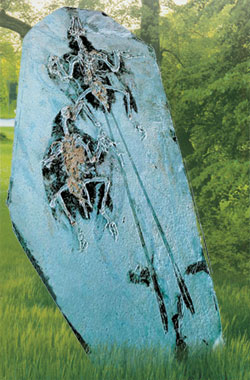 |
Two paleontologists, Lianhai Hou and Zhonghe Zhou, researching at the Vertebrate Paleontology Institute in China in 1995, discovered a new species of fossilized bird, which they named Confuciusornis sanctus. This was presented to the public as the earliest flying dinosaur, even as evidence for how hands used for grasping turned into hands used for flight. According to Alan Feduccia, however, this fossil is one of the frequently encountered beaked birds. This one had no teeth, and its beak and feathers share the same features as present-day birds. There are claws on its wings, as with Archaeopteryx, and its skeletal structure is identical to those of modern-day birds. A structure known as the pygostyle, which supports the tail feathers, can also be seen.
In short, evolutionists regarded this fossil as a semi-reptile, the earliest ancestor of all birds, of a similar age (about 142 million years) as Archaeopteryx and, bearing a close resemblance to present-day birds. This clearly conflicts with the evolutionist theses that Archaeopteryx is the earliest ancestor of all birds. 185
This is also definitive proof that Archaeopteryx and other archaic birds are not intermediate forms. These and similar fossils show no evidence that different bird species evolved from earlier ones. On the contrary, it proves that present-day birds and certain unique bird species similar to Archaeopteryx lived at the same time. Some of these species, such as Confuciusornis and Archaeopteryx, are extinct, but a few have survived to the present day.
What is in the heavens and in the Earth belongs to Allah. Allah encompasses all things. (Surat an-Nisa, 126)
4) Protarchaeopteryx Robusta and Caudipteryx Zoui: Vehicles for Biased Interpretations
Caudipteryx zoui, Protarchæopteryx robusta |
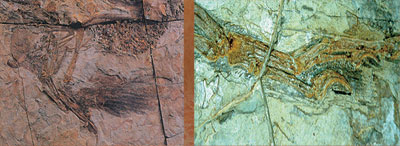 |
| The fossils Protarchæopteryx robusta and Caudipteryx zoui do not belong to dinosaurs, but to extinct flightless birds. The efforts to portray these creatures as dinosaurs is an example of evolutionists' eagerness to produce evidence. |
In the summer of 1996, farmers working in the Yixian Formation found three separate turkey-sized fossils, so well preserved as to give genuine evidence of bird feathers. At first, Ji Qiang and his colleague Ji Shu-An concluded that these fossils must belong to a single species. Noting their surprising similarity to Archaeopteryx, they gave the creature the name Protarchaeopteryx robusta.
During his research in the autumn of 1997, Philip Currie concluded that these fossils belonged to two different species, neither of which resembled Archaeopteryx. The second species was given the name Caudipteryx zoui. 186
The discoveries of the Protarchæopteryx robusta and Caudipteryx zoui fossils were depicted as evidence that birds evolved from theropod dinosaurs. 187 The popular press stated that these fossils were definitely the so-called ancestors of birds. One commentator even wrote that the dinosaur-bird link was "now pretty close to rock solid."188 However, this certainty was again, only a biased interpretation.
According to evolutionist claims, Caudipteryx and Protarchaeopteryx were small dinosaurs whose bodies were largely covered in feathers. But on their wings and tails were longer and more complex feathers, arranged like those in present-day birds. However, it is no surprise that these creatures should have feather arrangements similar to modern birds', because their feathers are symmetrically shaped, as observed in present-day flightless birds.189 Therefore, the creatures in question are flightless birds, not dinosaurs.
In severely criticizing the dino-bird dogma, Larry Martin and Alan Feduccia stated that these fossils were flightless bird species like the modern ostrich. 190
But adherents of the dino-bird theory are reluctant to accept this because they want to classify the creatures as dinosaurs, even though this fossil provides no support for evolutionist claims. Indeed, this fossil represents a new contradiction to evolutionists' alleged ancestral relationships.
 |
| While refuting the theory of evolution's dino-bird claims, the world of science also confirms that living things are perfectly created. The attitude of evolutionist scientists clearly reveals that they are blindly devoted to the theory in question. |
According to the evolutionist scenario, these dinosaurs and modern birds both have a special bone that lets them bend their wrists. Again according to evolutionist claims, this feature enabled them to move their forefeet in a wide manner, to catch fleeing prey with their long arms and gripping talons. This allegedly powerful beating movement represented an important part of the wingbeats the today's birds use to fly. However, such interpretations are scientifically invalid, because flight consists of far more complex actions than just wing beating:
Any forward beating movement gives rises to a counter impulse that propels the bird backward. For the purpose of flight, the main flight feathers are arranged at such an angle as to push the air back and propel the birds forwards. As in planes, the wings have a special aerofoil shape, which causes air to flow faster over the upper surface than the lower. This, according to the Bernoulli principle, reduces air pressure on the upper surface and creates lift. This is the main factor in take-off, but there is also the question of Newton's Third Law—the reaction to the air being propelled downward.). 191
In addition, the structure of a wing hypothesized to catch prey is very different from that created for beating in flight. A feathered wing is no advantage to a bird using its wings to catch prey, because a feathered wing's broad surface will only increase air resistance and make movement more difficult. If, the bird flapped for hunting, as evolutionists maintain then its wing structure should help the bird move forward by pushing air back. Therefore, it would be a greater advantage for the bird's wings to let air pass through them, like a sieve or flyswatter. Thus evolutionist accounts are full of illogicalities that conflict with their own claims.
In addition to its feathers, Caudipteryx has a series of other features showing it to be a bird—such as that it was carnivorous. Caudopteryx was portrayed as a theropod since it was first unearthed, it was thought to be a carnivore.192 But there were no teeth in its lower skull and lower jaw, and the first two fossil specimens contained the remains of crops that birds use for digesting plant materials.193 Organs such as the crop are found only in birds and not in any species of the theropod family. 194
Protarchæopteryx and Caudipteryx are therefore extinct birds. The only reason they are referred to as dinosaurs is because that's what evolutionists want them to be.
5) Sinosauropteryx: Another Fossil Subjected to Speculative Claims
 |
| Today's evolutionists have entirely abandoned their claim that the creature was feathered. But a dogmatic approach towards evolution and accepted preconceptions make such errors inevitable. |
With every new fossil discovery, evolutionists speculate about the dinosaur-bird link. Every time, however, their claims are refuted as a result of detailed analyses.
One example of such dino-bird claims was Sinosauropteryx, announced with enormous media propaganda in 1996. Some evolutionist paleontologists maintained that this fossil reptile possessed bird feathers. The following year, however, examinations revealed that these structures so excitedly described as feathers were actually nothing of the sort.
One article published in Science magazine, "Plucking the Feathered Dinosaur," stated that the structures had been misperceived as feathers by evolutionist paleontologists:
Exactly 1 year ago, paleontologists were abuzz about photos of a so-called "feathered dinosaur" . . . The Sinosauropteryx specimen from the Yixian Formation in China made the front page of The New York Times, and was viewed by some as confirming the dinosaurian origins of birds. But at this year's vertebrate paleontology meeting in Chicago late last month, the verdict was a bit different: The structures are not modern feathers, say the roughly half-dozen Western paleontologists who have seen the specimens. . . . Larry Martin of Kansas University, Lawrence, thinks the structures are frayed collagenous fibers beneath the skin—and so have nothing to do with birds. 195
About the speculative claims regarding feathers and Sinosauropteryx, Alan Brush of Connecticut University had this to say:
The stiff, bristlelike fibers that outline the fossils lack the detailed organization seen in modern feathers. 196
Another important point is that Sinosauropteryx had bellows-like lungs, like those in reptiles. According to many researchers, these show that the animal could not have evolved into modern-day birds with their high-performance lungs.
6) Eoalulavis Hoyasi Shares with Wing Structure of Modern-Day Birds
 |
| The wing structure in Eoalulavis hoyasi is also present in certain present-day flying birds. The feathers on this bird's wing contain a small bunch of feathers attached to the "finger". When the bird wishes to slow down or descend to earth, it decreases the angle of the wing to the horizon. This allows air to flow over the wing's top surface and to stop without falling. |
Another fossil to demolish evolutionist claims was Eoalulavis hoyasi. This, estimated at some 120 million years old, is older than all the known theropod specimens. Nonetheless, wing structure in Eoalulavis hoyasi is identical to some modern-day flying birds. This proves that vertebrates identical in many respects to modern birds were flying 120 million years ago.197 Any suggestion that theropods, which appeared after this creature, were the ancestors of birds is clearly irrational.
This bird's wing has a bunch of small feathers attached to the "finger." Recognizable as the alula, this structure is a basic feature of many birds alive today and consisting of several feathers that permits the bird to engage in various maneuvers during flight. But it had never before been encountered in a fossil bird from the Mesozoic. This new bird was given the name Eoalulavis hoyasi, or "ancient bird with an alula."198 Its presence shows that this bird, the size of a chaffinch, was able to fly and maneuver as well as modern-day birds.
The alula functions like the wing flap on an airplane. When the bird wants to reduce its speed or landing, it increases of its wing to the horizon. The drag produced by this wing position helps the bird to slow down. But when the angle between the direction of the air flow and the wing surface gets too steep, turbulence over the wing increases until the bird loses the lift necessary to maintain flight. Like an airplane under similar circumstances, the bird is in danger of stalling in midair. The alula now enters the equation. By raising this small appendage, the bird creates a slot between it and the main part of the wing, similar to what happens when a pilot deploys a craft's wing flaps. The slot allows air to stream over the main wing's upper surface, easing turbulence and allowing the bird (or plane) to brake without stalling. 199
Birds 120 million years ago were using the same technology as that employed present. This realization added yet another insuperable difficulty facing the theory of evolution.
7) Unenlagia Comahuensis: A Dino-Bird Based on Artists' Imaginations
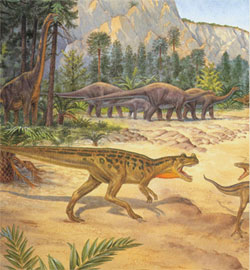 |
| Conjectural Drawing |
Fernando E. Novas of the Argentine Museum of Natural Sciences in Buenos Aires and Pablo F. Puerta of the Paleontology Museum in Trelew announced a new fossil, said to be 90 million years old, in the 22 May, 1997, edition of Nature magazine, under the caption "Missing Link."200 They named this fossil Unenlagia comahuensis, meaning "half-bird from north-west Patagonia." This fossil, discovered in Argentina's Patagonia region, consisted of more than 20 pieces of the creatures leg, rib and shoulder bones. Based on these fragments, artists drew a creature complete with a neck, jaw and tail—and subsequently announced that this fossil was an intermediate stage in the transition from dinosaurs to birds.
However, Unenlagia comahuensis is manifestly a dinosaur, in many respects. In particular, certain features of its skull and the bone formations behind its eyes closely resemble those of theropods. There is also no evidence at all that it bore feathers. Evolutionist scientists, however, claimed that by raising its forearms, it could make similar movements to those used by birds for flying. But clearly, these prejudiced guesses and assumptions cannot be regarded as definitive proof.
On account of its different features, Lawrence M. Witmer of Ohio University describes this creature as a genuine "mosaic". 201
Alan Feduccia also states that Unenlagia comahuensis cannot be a missing link between dinosaurs and birds, emphasizing that it lived 55 million years after Archaeopteryx. 202
As Feduccia stressed in a 1996 article written together with several other authors in Science magazine, almost every dinosaur said to resemble the bird dates back to long after the emergence of the first true birds.203 This creates the problem that scientists refer to as the time paradox.
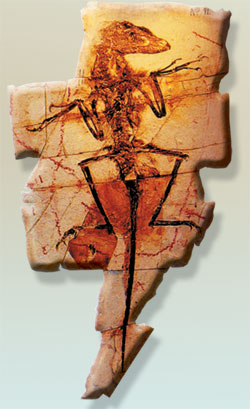 |
8) Dromaeosuar: The Dinosaur That Evolutionists Were
Determined to Make the Ancestor of Birds
When the Archaeoraptor fossil, regarded as the ancestor of birds, was unmasked, evolutionists next placed their hopes in a discovered fossil newly discovered in China and named Dromaeosaur. Thought to have certain bird-like characteristics, it was proposed as the ancestor of birds.
In fact, however, this fossil was a typical reptile. It had no wings, and its forearms were clawed. It had long rear legs and a long tail. Evolutionists sought to link the creature to birds only because of the structures resembling feathers on the upper part of its body.
Yet as Feduccia stated, these structures, present in all so-called feathered dinosaurs, are actually the dino-fuzz that results from the gradual breakdown and fragmentation of the skin. For evolutionists to claim that reptiles evolved into birds, there should be fossils from reptiles that lived before Archaeopteryx and which gradually developed bird-like characteristics. Yet there is not the slightest evidence of this.
9) Jeholornis Prima
Zhonghe Zhou, a Beijing researcher into paleoanthropology from the Vertebrate Paleontology Institute, and Fucheng Zhang discovered a fossil they named Jeholornis prima. This fossil bird's long tail led some evolutionists to point to it as evidence that birds were evolved from dinosaurs. But as we already pointed out, mosaic creatures have features belonging to different living groups, which species evolutionists propose as evidence for their theory.204 Insects, birds, and bats all have wings, yet even evolutionists can not suggest any evolutionary link between them. Therefore, certain similarities between dinosaurs and reptiles do not imply that the former are the ancestors of the latter.
As Alan Feduccia says:
If one views a chicken skeleton and a dinosaur skeleton through binoculars, they appear similar, but close and detailed examination reveals many differences. . . . Theropod dinosaurs, for example, had curved, serrated teeth, but the earliest birds had straight, unserrated peg-like teeth. They also had a different method of tooth implantation and replacement. 205
From that point of view, Jeholornis is not an intermediate form, but a fully fledged and powerful bird, albeit displaying mosaic features. 206
 |
| Protopteryx fengningensis |
10) Protoptryx Fengningensis
This fossil bird called Protopteryx fengningensis was discovered among 120-million-year-old Cretaceous strata in the Hebei region of China. In the 8 December, 2000, edition of Science magazine, paleontologists Fucheng Zhang and Zhonghe Zhou, from the Chinese Academy of Science in Beijing, declared this fossil was a new dino-bird.
This small bird was clearly capable of flight. It was covered in long feathers and had a pelvic bone that could assist flight. (The pelvic bone is found in many birds—including the hawk, an excellent flier—and various perching birds.) Yet evolutionists subjected this fossil to biased interpretations and portrayed it as an intermediate form. Alan Feduccia states that the traces seen in Protopteryx are a sign that birds were living before dinosaurs, meaning that there is no link between dinosaurs and birds. 207
11) The Imaginary Feathers of Sinovenator Changii
Despite no feathers being encountered on the 130-million-year-old dinosaur Sinovenator changii, again discovered in China, some evolutionists assume it to have been possibly feathered. The fact that other dinosaur fossils found in the same region were feathered was the basis for that assumption. Even though there are no feathers in the fossil, assuming that it had them and thus concluding that dinosaurs are definitely the ancestors of birds is not, of course, a scientific approach.
The feathers on the other dinosaur fossils found in the Yixian region are also questionable. As you have already seen, many scientists agree that the structures on these dinosaurs are not actually feathers at all.
No potential feathered dinosaur that has been proposed is beyond doubt. Even if certain feathery structures are encountered in dinosaur fossils, it's still not possible to establish with certainty whether these were real feathers or are just the extensions of ordinary reptile scales. As already set out, prominent evolutionists like Feduccia maintain that these structures are collagen fibers and that regarding them as feathers is a serious mistake.208 In 1997, as a result of observations, it was discovered that the Sinosauropteryx, announced with great media fanfare as a feathered dinosaur only the year before, had in fact no feather-like structures at all. 209
Even if feathered dinosaurs did exist, that would still constitute no evidence that birds evolved from dinosaurs. Birds' feathers are completely unique, and there is no evidence that they are evolved from any other structures.
12) Microraptor Gui and the Claims of Four-Winged Dinosaurs
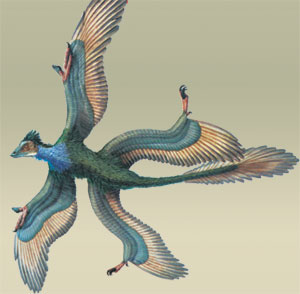 |
| Conjectural Drawing |
The fossil known as Microraptor gui, discovered by the Chinese paleontologist Xu Xing in January 2003, was accepted by evolutionists as the primitive ancestor of birds, in the same way as a great many other fossils. It was suggested that this reptile had four wings and glided from tree to tree, and was evidence that birds evolved from dinosaurs. Very soon afterwards, however, scientists announced that there was no evidence to support this claim.
To set out the invalidity of the Darwinist propaganda regarding the fossil Microraptor gui in articles and news reports:
1. The fossil in question was estimated to be 130 million years old—20 million years younger than Archaeopteryx. This shows that the title of "ancestor of birds" awarded to Microraptor gui by evolutionists is a fabrication.
2. Anatomically, Microraptor gui resembles dinosaurs. Its finger sequence agrees with that similarity. Yet the finger sequence in birds, suggested as having evolved from Microraptor gui, is significantly different. This difference is impossible to account for in terms of an ancestral relationship—another blow to the thesis that Microraptor gui was the ancestor of birds.
Considerable evidence shows that Microraptor gui is in fact a dinosaur. Indeed, the paleontologist who discovered and named the fossil wrote, in his report published in Nature, that it belonged to a dinosaur. 210
The finger sequence in Microraptor gui is 1, 2, 3 as in dinosaurs, and not 2, 3, 4 as in birds. Also, there are lethal claws on its hind feet—a characteristic feature of the dromaeosaurs—a group of small and medium-sized carnivorous dinosaurs that lived 144 to 66.4 million years ago.211 Even from an evolutionist perspective, this very different finger sequence makes it impossible to construct a family relationship between Microraptor gui and birds. 212
In general, the anatomy of birds is very different from that of dinosaurs, from which they are said to be descended— and thus, from that of Microraptor gui. 213
3. Scientific developments regarding Microraptor gui have shown that the creature may not have been able to glide in the air, as had once been estimated. Soon after Microraptor gui was described in Nature, objections began to emerge from the scientific world. Although Microraptor gui had been presented as a flying creature, to the accompaniment of great media fanfare, comments arose that in fact, it could not fly at all. In the face of these latest interpretations, National Geographic summarized the position of Microraptor gui:
But the Chinese team that studied M. gui, led by Xu Xing and Zhou Zhonghe of the Institute of Vertebrate Paleontology and Paleoanthropology, doesn't think this animal ran or flapped well enough to take off. Its leg feathers would've tripped it up like a hurdler in a ball gown.
Instead, the ample feathers could have formed an airfoil or parachute similar to those of flying squirrels and other tree-dwelling gliders, the scientists say. . . . Other scientists aren't sure what to make of the new fossil, arguing that gliding doesn't necessarily evolve into powered flight: Why waste energy beating your wings when you could take it easy?. . . Some researchers suggest that M. gui's leg feathers weren't useful for flight at all. 214
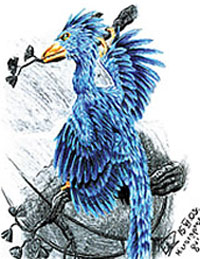 |
| Conjectural Drawing |
To sum up briefly the scientific facts regarding these objections:
A)Birds' pelvic bones refute the hypothesis that Microraptor gui glided in the air.
Evolutionists link this creature to the alleged evolution of flight because of the apparent feathers on its front and back legs. Some evolutionists suggest that this was a creature that lived in the trees and that glided from branch to branch by spreading its front and rear legs. In reconstructions published in the media, Microraptor gui appears with its rear legs spread open parallel to the ground. But in fact, it is impossible for birds to open their legs out 180 degrees to the side, because of the structure of their pelvic bones, For example, if you buy a chicken from the supermarket and open its legs out to the side, the hip bones will break.
B) Whether the feathers assumed to be on Microraptor gui's legs are actually attached to it or not is debatable. In addition, they are of a sort that would be an obstacle to flight and do not constitute evidence to support the alleged evolutionary origin of flight.
On the other hand, even if we assume that Microraptor gui's legs could open out to the side, there is no relationship between this creature's feathers and the flight feathers of birds. In an article in the May 2003 edition of the journal Bioscience, Kevin Padian, director of the California University Museum of Paleontology, opposed the thesis that Microraptor gui was linked to the origin of flight, setting out the obstacles that its anatomy posed to this scenario. 215
First, he is not convinced that the feathers claimed to be present in Microraptor gui were actually attached to its leg. Second, even if they were, there is no evidence that M. gui's supposed gliding movement could have evolved into the powerful wing flight in birds. Birds never use their rear legs in flight, but keep them trailing backwards, or tucked up against the body like the wheels of an airplane. After setting out these facts, Padian comments: "So the leg feathering in Microraptor has nothing demonstrably to do with the evolution of the kind of flight that more derived birds use." 216
Henry Gee, a paleontologist and also editor of the evolutionist magazine Nature, states that Microraptor gui's gliding movement had nothing to do with bird flight: "Four wings is a perfect recipe for gliding, but not powered, flapping flight." 217
The Age Problem and the Cladistic Error
Adherents of the dino-bird theory maintain that the small, carnivorous theropods were the so-called ancestors of birds. They point to certain fossil species discovered in the Liaoning region of China as an evolutionary ancestor, ignoring the fact that even before the theropod dinosaurs had even appeared, there were already birds on Earth capable of regular flight. Archaeopteryx, the oldest bird, lived 150 million years ago—tens of millions of years older than theropod dinosaurs.
Alan Feduccia therefore says that in terms of evolution, Archaeopteryx represents an insurmountable problem:
There are insurmountable problems with that theory. Beyond what we have just reported, there is the time problem in that superficially bird-like dinosaurs occurred some 25 million to 80 million years after the earliest known bird, which is 150 million years old. 1
Asked during an interview why he does not believe that birds are descended from dinosaurs, he replied:
First, the time line is all wrong. These alleged dinosaurian ancestors of birds occur 25 million to 80 million years after Archaeopteryx... Second... Evolving flight from the ground up is biophysically implausible. Third, many of the features of birds and dinosaurs—the hands and teeth, for example—don't match. The theropod dinosaur hand consists of the thumb and the next two fingers. The bird hand is made up of the middle three fingers. You can't just flip a switch to go from one type of hand to the other. Of course, it doesn't matter what line of evidence you come up with, you are automatically wrong if it is anything contrary to the dinosaurian origins of birds. 2
Evolutionists resort to the cladistic technique in order to resolve this major problem—or rather, to give the impression of doing so.
Proponents of this new method of fossil interpretation, frequently employed in the world of paleontology in the last 20 to 30 years, maintain that the age of fossils should be completely ignored, that their characteristic features should be compared and evolutionary family trees produced on the basis of the emerging similarities. This summary shows what a huge distortion the method actually creates, by assuming that a 70-million-year-old fossilized species actually lived 170 million years ago, and to build an evolutionary chain of descent on that basis.
Despite being an evolutionist, the paleontologist Larry Martin states just how dogmatic and prejudiced evolutionists' attitude is:
…I am annoyed with dogmatic statements including hints like, "if you make cladistic analysis you will attain the truth." Experimentally you know this is inaccurate, because if you look exactly, all of the expert cladists [one who classifies organisms according to the principles of cladistics] working on the same group will attain different cladograms [a branching, treelike diagram in which the endpoints of the branches represent specific species of organisms]. You know, at best, only one of these cladograms is true. That is probably because it is related to how attentively people examine and select the features included in their cladograms. If you put trash in your cladogram, you will end up with trash. 3
Peter Dodson, the Pennsylvania University professor of anatomy, states that the presence of alleged dino-birds following the first birds represents a major difficulty and that using the cladistic method is a forced solution:
Personally, I continue to find it problematic that the most birdlike maniraptoran theropods are found 25 to 75 million years after the origin of birds . ...Ghost lineages are frankly a contrived solution, a deus ex machina required by the cladistic method. Of course, it is admitted that late Cretaceous maniraptorans are not the actual ancestors of birds, only "sister taxa." Are we being asked to believe that a group of highly derived, rapidly evolving maniraptorans in the Jurassic gave rise to birds, as manifested by Archaeopteryx, and then this highly progressive lineage then went into a state of evolutionary stasis and persisted unchanged in essential characters for millions of years? Or are actual ancestors far more basal in morphology and harder to classify? If the latter, then why insist that the problem is now solved? 4
The cladistic method is actually a covert admission that the fossil record contradicts the theory of evolution. To summarize:
1) Darwin predicted that detailed examination of the fossil record would yield intermediate forms to fill the gaps between all the known species. This was the expectation of the theory.
2) However, 150 years of paleontological endeavor have revealed no intermediate forms. No trace of such creatures has ever been found.
3) Just as there are no intermediate forms, the ages of the creatures claimed to be one another's ancestors, solely on the basis of similarities, is also inconsistent. A species that appears to be more primitive should not be younger than another species that appears more advanced.
This final objection obliged evolutionists to develop the inconsistent method known as cladistics.
With cladistics, Darwinism loses its scientific mask and becomes a dogma that distorts scientific findings in line with its own preconceptions.
Footnotes 1
1. David Williamson, "Scientist says ostrich study confirms bird 'hands' unlike those of dinosaurs," UNC News, No. 425, 14 August 2002, www.unc.edu/news/newsserv; David Williamson; Scientist Says Ostrich Study Confirms Bird 'Hands' Unlike Those Of Dinosaurs," EurekAlert, 14 August 2002, http://www.eurekalert.org/pub_releases/2002-08/uonc-sso081402.php 
2. Alan Feduccia, "Plucking Apart the Dino-Birds," Discover, Vol. 24, No. 2, February 2003. 
3. Case of the Flying Dinosaur, NOVA, Boston Video, 1991. 
4. Peter Dodson, "Response by Peter Dodson," American Paleontologist, Vol. 9, No. 4, 2001, pp. 13-14. 
A Problem That Evolutionists Ignore: The Dating Paradox That Damages the Supposed Ancestral Family Tree
Fossils depicted as so-called feathered dinosaurs are far younger than the well known Archaeopteryx. This, the earliest known flying bird on Earth, is around 150 million years old, and had exactly the same flying ability as birds in our day. Therefore, it's impossible to portray these fossils as the as-yet-flightless ancestors of birds. That these supposedly feathered dinosaurs are much younger than they should be represents one of the insoluble difficulties facing evolutionists.
Another fossil that spoils evolutionists' supposed ancestral relationships: Liaoningornis
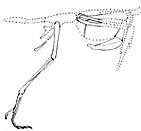 |
| Conjectural Drawing |
The 121-million-year-old fossil Liaoningornis, found in China in November 1996, was announced in a Science magazine article by Lianhai Hou, Larry Martin and Alan Feduccia.1 Liaoningornis had a breastbone to which the flight muscles in modern birds are attached, and flight muscles permitting long flight. In other respects, too, this creature was identical to today's birds. The only difference was that it had teeth.
This showed that, contrary to evolutionist claims, toothed birds are not primitive.2 Indeed, Alan Feduccia stated in Discover magazine that Liaoningornis made it impossible for dinosaurs to represent the origin of birds.3
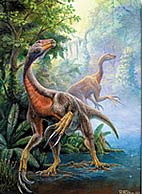 |
| Conjectural Drawing |
Sinornithosaurus Millenii and Beipiaosaurus Inexpectus
These dinosaur fossils, discovered in China, are represented as half-bird, half-dinosaur in evolutionist sources. Chris Sloan, an evolutionist paleontologist who analyzed the fossils, suggests that the creatures were unable to fly, but used their wings for balance when running. According to these claims, these fossils are of bird predecessors that were as yet unable to fly. Yet it is a major contradiction to depict these fossils, which lived some 120 million years ago, as supposed ancestors.
BPM 1 3-13
One of the fossils most raised in connection with feathered dinosaur claims was discovered by Dr. Mark Norell, together with a number of Chinese scientists. He gave it the name BPM 13-13, inspired by the Beipiao Palaeontological Museum in the Liaoning region of China.
A Dinosaur Fossil Deliberately Alleged to Have Avian Characteristics: Microraptor
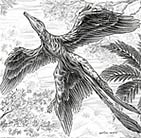 |
| Conjectural Drawing |
This dinosaur fossil was discovered in China and estimated to be 120 million years old. That it was small in size and possessed the organic structure known as "dino-fuzz",4 —which actually has nothing to do with bird feathers—led to its being interpreted as the ancestor of birds.
However, as appeared in the original report announced by the Associated Press, there is no evidence that this dinosaur flew.
In that same report, the Kansas University paleontologist Larry Martin states that the dinosaur was not adapted for flight.5
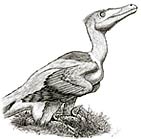 |
| Conjectural Drawing |
A Dinosaur Fossil Suggested to Been Feathered by Means of Illustrations: Velociraptor
The 80-million-year-old Velociraptor is one of those fossils suggested as a so-called transitional form of birds evolving from dinosaurs.
Like the others, however, this is a biased evolutionist interpretation, and the feathers depicted in representations are entirely imaginary. In truth, there is no evidence that these creatures had feathers.
Another Flying Dinosaur Myth from Evolutionists: Shenzhouraptor Sinensis
 |
| Conjectural Drawing |
This 10-million-year-old fossil discovered in the Yixian region of China, given the name Shenzhouraptor sinensis, was declared to be a transitional form between dinosaurs and modern-day birds by the paleontologist Ji Qiang.
This fossil, reported to the accompaniment of "Missing Link Found!" headlines from evolutionists, actually conflicts with evolutionist claims regarding the origin of birds and with the so-called evidence they present.
Conclusion
Scientific evidence shows a great many reasons why dinosaurs could not have evolved into birds. No fossil claimed to represent the primitive ancestor of birds actually possesses any such property. The oldest known bird, Archaeopteryx, appears suddenly in the fossil record together with its flawless flight system. No primitive bird existed before. The recent dino-bird claims lack any scientific foundation. Alan Feduccia comments on the despair of the adherents of the theory: "Nowhere has the trap been more successful than in luring paleontologists to the theropod dinosaurian origin of birds." 218
In his 1999 book, Feduccia summarizes the facts regarding all these claims:
Finally, no feathered dinosaur has ever been found, although many dinosaur mummies with well-preserved skin are known from diverse localities. 219
Even if these inferences about feathered dinosaurs were true, they would still not benefit the theory of evolution. Throughout natural history, tens of millions of species have created a broad biological spectrum, and most of these have become extinct. Winged mammals such as the bat are still alive today, and winged reptiles (pterosaurs) lived in the past. A great many different marine reptiles (ichthyosaurs, for instance) became extinct. Yet the striking aspect of this rich spectrum is how species with vastly different characteristics or anatomical structures appear suddenly in the record, with no primitive forms behind them.
All the complex and unique structures of bird feathers appear all at once in Archaeopteryx. There are no primitive feathers or primitive flight. The avian lung's irreducibly complex structure makes any primitive version impossible. Fossil findings continue to confirm the fact that living things appeared on Earth through creation, not through evolution, and no dino-bird fanfare can ever alter that truth.
The true origin of birds and all other living things is creation. Living things were created by the will of Allah, flawlessly and in a single moment. In one verse of the Qur'an, it is revealed that He is:
The Originator of the heavens and Earth. When He decides on something, He just says to it, "Be!" and it is. (Surat al-Baqara, 117)
Footnotes
170. Scott F. Gilbert, "Did Birds Evolve from the Dinosaurs?," Developmental Biology, 6th edition, Ch. 16.4; http://www.devbio.com/article.php?ch=16&id=161 
171. "Case of the Flying Dinosaur," NOVA, Boston Video, 1991. 
172. Peter Dodson, "Mesozoic Feathers and Fluff," American Paleontologist, 2001, Vol. 9, No. 1, p. 7. 
173. Peter Dodson, "Response by Peter Dodson," American Paleontologist, 2001, Vol. 9, No. 4, pp. 13-14. 
174. Alan Feduccia, "Birds are Dinosaurs: Simple Answer to a Complex Problem," The Auk, Vol. 119, No. 4, October 2002, pp. 1187-1201 (Emphasis added). 
180. Peter Dodson, "Origin of Birds: The Final Solution?," American Zoologist, Vol. 40, 2000, pp. 505-506. 
181. Richard Monastersky, "A Clawed Wonder Unearthed in Mongolia," Science News, Vol. 143, 17 April 1993, p. 245. 
182. Cynthia Reynolds, "New dinosaur find: missing link between dinos and birds?," 21 March 2000; http://exn.ca/Templates/Story.asp?ID=2000032156 
183. "Ancient Feathered Animal Challenges Dinosaur-Bird Link," 26 June 2000; http://www.sciencedaily.com/releases/2000/06/000625231641.htm 
184. Alan Feduccia, e-mail message.12 November 2003, 
185. Pat Shipman, "Birds do it . . . Did Dinosaurs?," New Scientist, 1 February 1997, p. 31. 
186. Ann Gibbons, "Dinosaur Fossils, in Fine Feather, Show Link to Birds," Science, Vol. 280, 1998, p. 2051; Jennifer Ackerman, "Dinosaurs Take Wing," National Geographic, Vol. 194, 1998, pp. 86-89; D. M. Unwin, "Feathers, filaments and theropod dinosaurs," Nature, Vol. 391, 1998, p. 120. 
187. Ji, Qiang, Philip J. Currie, Mark A. Norell, Ji Shu-An, "Two feathered dinosaurs from northeastern China," Nature, Vol. 393, 1998, pp. 753-761; Jennifer Ackerman, "Dinosaurs Take Wing," National Geographic, Vol. 194, 1998, pp. 86-89; David E. Fastovsky, David B. Weishampel, The Evolution and Extinction of the Dinosaurs, Cambridge: Cambridge University Press, 1996, pp. 261, 271-272; Robert L. Carroll, Vertebrate Paleontology and Evolution, New York: W. H. Freeman, 1988. 
188. Michael D. Lemonick, "Dinosaurs of a Feather," Time, 6 July 1998, p. 83. 
189. Ann Gibbons, "Dinosaur Fossils, in Fine Feather, Show Link to Birds," Science, 1998, Vol. 280, p. 2051; R. Monastersky, "Feathered Dinosaurs Found in China," Science News, 1998, Vol. 153, p. 404; Kevin Padian, "When is a bird not a bird?," Nature, Vol. 393, 1998, p. 730; Chen Pei-ji, Zhi-ming Dong, Shuo-nan Zhen, "An exceptionally well-preserved theropod dinosaur from the Yixian Formation of China," Nature, Col. 391, 1998, pp. 151-152; Jennifer Ackerman, "Dinosaurs Take Wing," National Geographic, Vol. 194, 1998, p. 90. 
190. Alan Feduccia, "1,2,3 = 2,3,4: Accommodating the cladogram," Proceedings of National Academy of Sciences, Vol. 96, No. 9, 27 April 1999, pp. 4740-4742. 
191. http://www.answersingenesis.org/docs2002/1126dinosaur.asp; [David Anderson, Scott Eberhardt, "A Physical Description of Flight"; http://www.aa.washington.edu/faculty/eberhardt/lift.htm] 
192. David E. Fastovsky, David B. Weishampel, The Evolution and Extinction of the Dinosaurs, Cambridge: Cambridge University Press, , 1996, pp. 261, 284-287. 
193. Ji Qiang, Philip J. Currie, Mark A. Norell, Ji Shu-An, "Two feathered dinosaurs from northeastern China," Nature, Vol. 393, 1998, p. 759; David E. Fastovsky, David B. Weishampel, The Evolution and Extinction of the Dinosaurs, Cambridge: Cambridge University Press, Cambridge, 1996, p. 435; Alan Feduccia, The Origin and Evolution of Birds, New Haven: Yale University Press, 1996, pp. 5, 281-282. 
194. David E. Fastovsky, David B. Weishampel, The Evolution and Extinction of the Dinosaurs, pp. 125, 182, 254-255. 
195. Ann Gibbons, "Plucking the Feathered Dinosaur," Science, Vol. 278, No. 5341, 14 November 1997, p. 1229-1230 (Emphasis added). 
197. Pat Shipman, "Birds Do It . . . Did Dinosaurs?," New Scientist, p. 28. 
198. Luis M. Chiappe, "Wings over Spain," Natural History, Spain, September 1998. 
200. F. E. Novas, P. F. Puerta, "New evidence concerning avian origins from the Late Creataceous of Patagonia," Nature, Vol.. 387, No. 6631, 1997, pp. 390-392. 
201. Corey S. Powell, "It's a Bird, It's a . . . Dinosaur?," Scientific American, 23 June 1997. 
202. Alan Feduccia, "Evidence from Claw Geometry Indicating Arboreal Habits of Archæopteryx," Science, Vol. 259, pp. 790-793. 
203. Lianhai Hou, Larry D. Martin, Zhonghe Zhou, Alan Feduccia, "Early Adaptive Radiation of Birds: Evidence from Fossils from Northeastern China," Science, 15 November 1996, Vol. 274, No. 5290, pp. 1164-1167. 
204. S. J. Gould, N. Eldredge, Paleobiology, Vol. 3, 1977, p. 147. 
205. David Williamson, "Scientist says ostrich study confirms bird 'hands' unlike those of dinosaurs," EurekAlert, 14 August 2002; http://www.eurekalert.org/pub_releases/2002-08/uonc-sso081402.php 
206. Henry Gee, "Early bird ate seeds," Nature, 25 July 2002. 
207. http://www.jpinstitute.com/news/jns_new_bird_find.jsp 
208. Alan Feduccia, The Origin and Evolution of Birds, 2nd Edition, New Haven: Yale University Press, 1999. 
209. Ann Gibbons, "Plucking the Feathered Dinosaur," Science, Vol. 278, 14 November 1997, p. 1229. 
210. Xu, X., Zhou, Z., Kuang, X., Zhang, F., Du, X., "Four winged dinosaurs from China," Nature, Vol. 421, 2003, pp. 335-339. 
211. Justin Costa Rica, "Microraptor gui: Bird or Dinosaur? A look into the therapod dinosaur-bird evolution debate;" http://www.ndsu.nodak.edu/instruct/ashworth/webpages/g491/2003presentations/justin costarica/Seminar.htm 
212. David Williamson, "Scientist says ostrich study confirms bird 'hands' unlike those of dinosaurs," EurekAlert, http://www.eurekalert.org/pub_releases/ 2002-08/uonc-sso081402.php 
213. Pat Shipman, "Birds Do It . . . Did Dinosaurs?," New Scientist, p. 28. 
214. Christopher P. Sloan, "The Lord of the Wings," National Geographic, May 2003. 
215. Kevin Padian, "Four-Winged Dinosaurs, Bird Precursors, or Neither?." BioScience, Vol. 53, No. 5, pp. 450-452. 
217. Henry Gee, "Fossil boosts trees-down start for flight," Nature, Science Update, 23 January 2003. 
218. Alan Feduccia, The Origin and Evolution of Birds, 1996, p. viii. 
